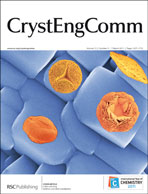Five novel hybrid compounds, [Mo8O26Cu2(4-abpt)2]n·4nH2O (1), (4-H2abpt)2[Mo8O26] (2), [Mo8O26Cu2(3-abpt)2(H2O)2]n (3), [MoO4Cu(3-abpt)(H2O)]n (4), and [Mo6O19Co(3-abpt)2]n·4nH2O (5) were prepared by reacting MoO3/(NH4)6Mo7O24 with 4-amino-3,5-bis(3/4-pyridyl)-1,2,4-triazole (3/4-abpt) and corresponding metal salts. Compound 1 is a 2D coordination polymer containing extended γ-[Mo8O26]4− and [Cu2(4-abpt)2]4+ ribbons. Compound 2 is a supramolecular hybrid aggregate composed of H-bond linking β-[Mo8O26]4− and 4-H2abpt2+. Compound 3 exhibits a 2D rectangular network constructed by isolated β-[Mo8O26]4−clusters and [Cu2(3-abpt)2]4+. In compound 4, each MoO42− anion links two Cu(II) ions to form a S-type [CuMoO4]n chain, which is further linked by bidentate 3-abpt to form a 2D wave-like network. In complex 5, unprecedented cyclic [Mo6O19]2−cluster links two neighbouring hexamolybdates and two Co(II) ions to form a 2D [CoMo6O19]n network, which is further pillared by tetradentate 3-abpt to generate a 3D metal–organic framework. These compounds are thermally stable under 250 °C. The composites of the final residues were analyzed by PXRD.
![Graphical abstract: Unprecedented cyclic [Mo6O19]2−cluster and five organic–inorganic hybrids based on polyoxomolybdates and 4-amino-3,5-bis(pyridyl)-1,2,4-triazole](/en/Image/Get?imageInfo.ImageType=GA&imageInfo.ImageIdentifier.ManuscriptID=C002063J&imageInfo.ImageIdentifier.Year=2011)
You have access to this article
 Please wait while we load your content...
Something went wrong. Try again?
Please wait while we load your content...
Something went wrong. Try again?
![Graphical abstract: Unprecedented cyclic [Mo6O19]2−cluster and five organic–inorganic hybrids based on polyoxomolybdates and 4-amino-3,5-bis(pyridyl)-1,2,4-triazole](/en/Image/Get?imageInfo.ImageType=GA&imageInfo.ImageIdentifier.ManuscriptID=C002063J&imageInfo.ImageIdentifier.Year=2011)

 Please wait while we load your content...
Please wait while we load your content...